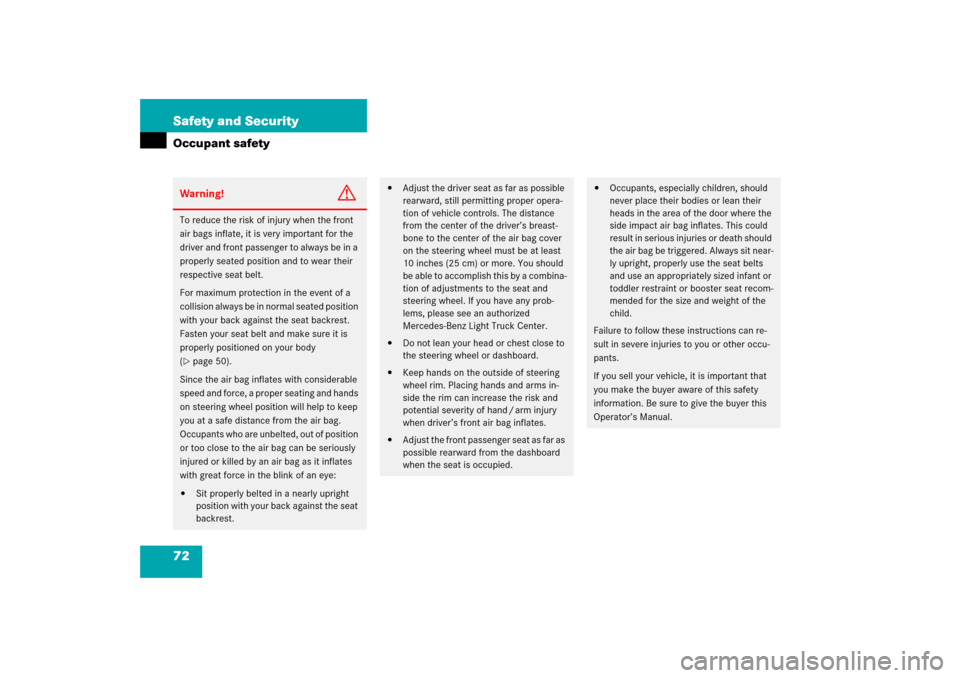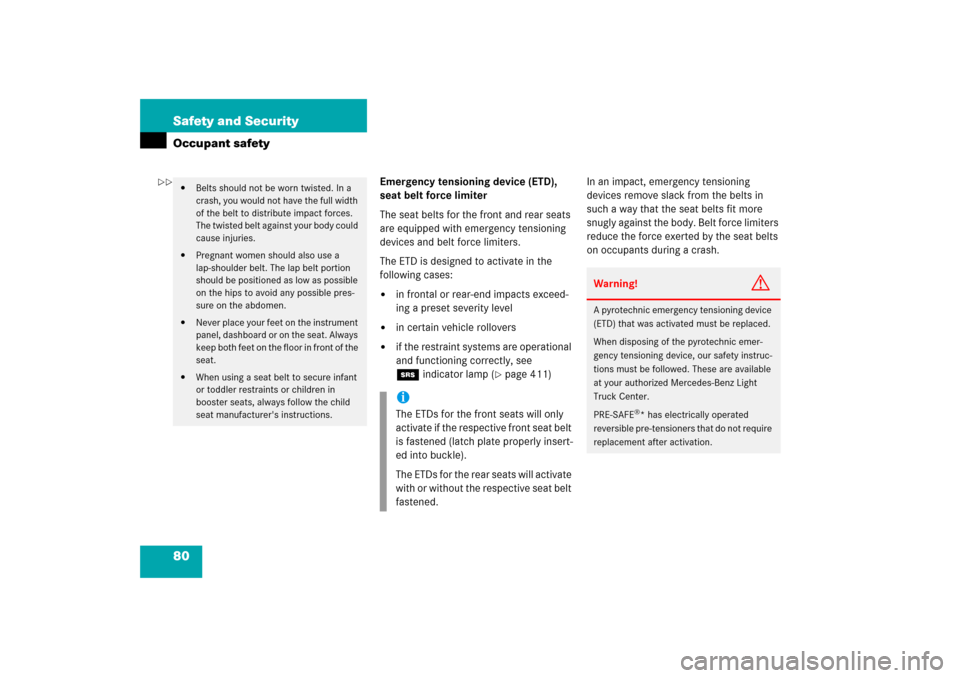Page 73 of 561

72 Safety and SecurityOccupant safetyWarning!
G
To reduce the risk of injury when the front
air bags inflate, it is very important for the
driver and front passenger to always be in a
properly seated position and to wear their
respective seat belt.
For maximum protection in the event of a
collision always be in normal seated position
with your back against the seat backrest.
Fasten your seat belt and make sure it is
properly positioned on your body
(�page 50).
Since the air bag inflates with considerable
speed and force, a proper seating and hands
on steering wheel position will help to keep
you at a safe distance from the air bag.
Occupants who are unbelted, out of position
or too close to the air bag can be seriously
injured or killed by an air bag as it inflates
with great force in the blink of an eye:
�
Sit properly belted in a nearly upright
position with your back against the seat
backrest.
�
Adjust the driver seat as far as possible
rearward, still permitting proper opera-
tion of vehicle controls. The distance
from the center of the driver’s breast-
bone to the center of the air bag cover
on the steering wheel must be at least
10 inches (25 cm) or more. You should
be able to accomplish this by a combina-
tion of adjustments to the seat and
steering wheel. If you have any prob-
lems, please see an authorized
Mercedes-Benz Light Truck Center.
�
Do not lean your head or chest close to
the steering wheel or dashboard.
�
Keep hands on the outside of steering
wheel rim. Placing hands and arms in-
side the rim can increase the risk and
potential severity of hand / arm injury
when driver’s front air bag inflates.
�
Adjust the front passenger seat as far as
possible rearward from the dashboard
when the seat is occupied.
�
Occupants, especially children, should
never place their bodies or lean their
heads in the area of the door where the
side impact air bag inflates. This could
result in serious injuries or death should
the air bag be triggered. Always sit near-
ly upright, properly use the seat belts
and use an appropriately sized infant or
toddler restraint or booster seat recom-
mended for the size and weight of the
child.
Failure to follow these instructions can re-
sult in severe injuries to you or other occu-
pants.
If you sell your vehicle, it is important that
you make the buyer aware of this safety
information. Be sure to give the buyer this
Operator’s Manual.
Page 76 of 561

75 Safety and Security
Occupant safety
When you sell your vehicle we strongly
urge you to give notice to the subsequent
owner that it is equipped with an SRS by
alerting them to the applicable section in
the Operator’s Manual.Front air bags
1Driver air bag
2Passenger air bag
Driver and front passenger air bags are
deployed:
�
in the event of certain frontal impacts
�
if impact exceeds a preset deployment
threshold
�
independently of the side impact air
bags
�
Never place your feet on the instrument
panel, dashboard, or on the seat. Always
keep both feet on the floor in front of the
seat.
�
In addition, improper repair work on the
SRS creates a risk of rendering the SRS
inoperative or causing unintended air
bag deployment. Work on the SRS must
therefore only be performed by qualified
technicians. Contact an authorized
Mercedes-Benz Light Truck Center.
�
For your protection and the protection
of others, when scrapping the air bag
unit or emergency tensioning device,
our safety instructions must be fol-
lowed. These instructions are available
from your authorized Mercedes-Benz
Light Truck Center.
�
Given the considerable deployment
speed, required inflation volume, and
the textile structure of the air bags,
there is the possibility of abrasions or
other more significant injuries resulting
from air bag deployment.
Warning!
G
Only use seat covers which have been test-
ed and approved by Mercedes-Benz for your
vehicle model. Using other seat covers may
interfere with or prevent the deployment of
the front side impact air bags or the rear
side impact air bags*. Contact your autho-
rized Mercedes-Benz Light Truck Center for
availability.
Page 81 of 561

80 Safety and SecurityOccupant safety
Emergency tensioning device (ETD),
seat belt force limiter
The seat belts for the front and rear seats
are equipped with emergency tensioning
devices and belt force limiters.
The ETD is designed to activate in the
following cases:�
in frontal or rear-end impacts exceed-
ing a preset severity level
�
in certain vehicle rollovers
�
if the restraint systems are operational
and functioning correctly, see
1indicator lamp (
�page 411)In an impact, emergency tensioning
devices remove slack from the belts in
such a way that the seat belts fit more
snugly against the body. Belt force limiters
reduce the force exerted by the seat belts
on occupants during a crash.
�
Belts should not be worn twisted. In a
crash, you would not have the full width
of the belt to distribute impact forces.
The twisted belt against your body could
cause injuries.
�
Pregnant women should also use a
lap-shoulder belt. The lap belt portion
should be positioned as low as possible
on the hips to avoid any possible pres-
sure on the abdomen.
�
Never place your feet on the instrument
panel, dashboard or on the seat. Always
keep both feet on the floor in front of the
seat.
�
When using a seat belt to secure infant
or toddler restraints or children in
booster seats, always follow the child
seat manufacturer's instructions.
iThe ETDs for the front seats will only
activate if the respective front seat belt
is fastened (latch plate properly insert-
ed into buckle).
The ETDs for the rear seats will activate
with or without the respective seat belt
fastened.
Warning!
G
A pyrotechnic emergency tensioning device
(ETD) that was activated must be replaced.
When disposing of the pyrotechnic emer-
gency tensioning device, our safety instruc-
tions must be followed. These are available
at your authorized Mercedes-Benz Light
Truck Center.
PRE-SAFE
®* has electrically operated
reversible pre-tensioners that do not require
replacement after activation.
��